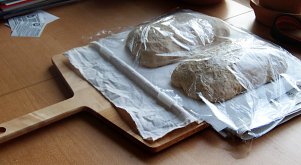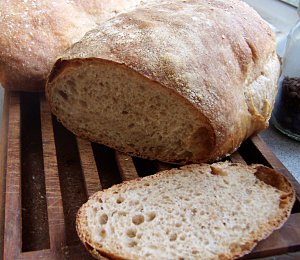I’ve had Daniel Leader’s Local Breads: Sourdough and whole-grain recipes from Europe’s best artisan bakers long enough to read most of the text in the book and bake three of the more than fifty bread recipes inside. The book begins with a few introductory chapters discussing the methods, ingredients and equipment you’ll need to bake the breads in the book. Subsequent chapters begin with a long section describing Leader’s experiences in a particular region of Europe, discussing the bakers, ingredients and bakeries he came across in his travels. After that, there are several recipes based on what he learned. The recipes are all scaled down for home ovens and equipment, have ingredients measured in volumetric units, U.S. and metric weights, as well as baker’s percentages. He says that he tested all the recipes using a small KitchenAid mixer, and the mixing instructions include specific details on speed and time for that mixer (as well as hand kneading instructions for most doughs). The majority of the recipes use sourdough for the fermentation, but including whole-grain in the title is a bit of a stretch since very few recipes are more than ten or twenty percent whole-grain (not a complaint, just a warning). At the end of the regional chapters is a list of frequently asked questions and answers that are tailored to the recipes. This is a nice Book 2.0 addition that would be welcome in most sophisticated baking books.
The three breads I’ve baked so far are his Old World Baguette (Paris), Buckwheat Batard (also Paris), and Whole Wheat Genzano Country Bread (Genzano, Italy). All of them were excellent, and the techniques involved were different from the recipes I’ve tried from Hamelman, Reinhart, or Beranbaum mostly because the doughs were so wet that they were difficult to shape using the techniques I’ve used in the past. If you’re going to be baking the breads from this book, you’ll probably need a good peel or a lot of parchment paper and a stand mixer.
Because the recipes are taken from different regions with their own baking traditions, there is less unity in technique than in the other books mentioned. Hamelman focuses on developing gluten with as little mixing and kneading as possible to maximize flavor and longevity, and the Reinhart whole grain book I recently reviewed revolves around pre-ferments and soakers or mashes. In Leader’s book you’ll find recipes using liquid levian, dough-like starters and starters raised on different grains; long-fermenting recipes with retarted proofing and recipes that are ready to bake a few hours after you start; recipes with a lot of kneading and recipes with much less. It’s a nice variety, and I’ve enjoyed seeing the results of variations in ingredients and technique in the final bread.
My only complaint with the book is that it’s not a sewn binding, which means that the book will eventually fall apart with the hard use it experiences in the kitchen. Hamelman’s bread book suffers from the same poor quality binding, and my copy recently split after three years of use. Contrast that with Whole Grain Breads, which has a sewn binding: it lays flat on the counter and will last a lifetime. Considering that both books list for $35, it’s a shame that Norton couldn’t produce a book up to the standards set by Ten Speed Press.
One other note: I’ve used my new SuperPeel (it’s the peel in the top photo) four or five times and I’m very happy with it. Thus far I haven’t used it to pick anything up, but it’s very good at smoothly laying dough down onto my baking stone in the oven, and when the belt is properly floured, the dough doesn’t stick to it. The only issue so far is that I haven’t found the optimum belt length yet such that the belt is tight to the peel but still allows it to move easily. My previous method for handling dough was to proof the loaves on a Silpat, which is a sort of reusable silicone parchment paper. It is very durable and works, but because the bread isn’t being place directly onto the heated stone, I wasn’t getting as much oven spring as I do now with the SuperPeel. Later this week I’m planning to make pizza, and we’ll see how easy it is to pick up and put down a big pizza. That’s the true test.

